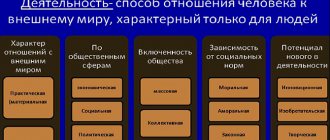Everything that a person considers valuable to himself is a reward. Motivation of employees should be carried out by the manager with knowledge of the needs of his subordinates. The purpose of the motivation function is to ensure that members of the organization perform work in accordance with the plan and in accordance with the responsibilities delegated to them. Consider the following motivation factors:
- wage
- working environment
- stability
- own development
- usefulness of work
- interest in work
All human needs have a certain hierarchy. The hierarchy of needs can be presented in different ways.
There are two main directions of motivation theory:
- Classic theories of motivation include those of A. Maslow, D. McClelland, F. Herzberg.
- Process theories of motivation that focus on the process of motivation. These include V. Vroom's theory, the theory of justice and the Porter-Lawler theory.
Brief description of classical theories of motivation
- A. Maslow's hierarchy of needs theory. Thus, the American scientist A. Maslow identified five needs: physiological, the need for safety and security, social, respect, and self-expression. At a certain moment, one need dominates, but human activity is stimulated not only by it.
- Theory of D. McClelland. Another model of motivation is the one that places the main emphasis on the needs of higher levels, was the theory of David McClelland. He suggested that people have three needs: power, success and belonging. The desire to influence others is expressed in the need for power. The need for success is satisfied by the process of bringing a job to a successful conclusion, rather than by proclaiming that person's success by confirming his status. The motivation for the need for involvement according to D. McClelland is similar to social motivation according to A. Maslow. Such people are interested in the company of acquaintances, establishing friendships, and helping others.
- The problems of motivation were also considered in his works by the American scientist F. Herzberg, who divided incentives into motivators and hygiene factors. He included wages, working conditions, psychological climate, and the degree of direct control over work as hygienic factors, and promotion, success, approval of work results, and recognition as motivators. Hygienic factors, according to F. Getsberg, are associated with the external environment, motivation - with the nature and essence of work. In the absence or insufficient degree of presence of hygiene factors, a person develops job dissatisfaction, thus, the presence of hygiene factors only prevents the development of job dissatisfaction. The manager must delve into the essence of the work himself and use “motivations” in order to effectively motivate his subordinates.
What motivates a person to do work?
A person is motivated by certain needs and goals that he wants to achieve when performing work. Often there are many needs and desires. They must be meaningful to motivate a person. Motivation should be distinguished from motivation - justification of committed actions.
Motivation for activity is determined by attitudes - stereotypical thoughts in behavior. An attitude is a persistent thought to perform a certain action.
Modern managers are required to understand the psychology of motivation. To achieve successful results, employees need to be motivated. And here it is very important to know the needs of each employee in order to be able to satisfy them, and thereby motivate subordinates.
Having your own business or being a manager in someone else’s company, you will certainly encounter a situation where your subordinates do not listen to you, shirk from work and perform assigned tasks poorly. In order for the business to move forward, you need to quickly, on time and efficiently complete all the necessary tasks. They are entrusted to subordinates. But people can't cope. Fire? Find others? This approach can also be used. But what to do if we are talking about valuable employees, professionals in their field? How to motivate them so that they do their work with pleasure? An individual approach is needed here.
Depending on how a person was encouraged by his parents and teachers when he was little, he still expects this form of motivation from his boss. People are motivated differently, so it is better to take an individual approach to motivating each individual subordinate. How can you motivate an employee?
- Certificates, medals, thanks.
- Increasing the level of wages.
- Advancement up the career ladder.
- An opportunity for self-realization.
- Receiving bonuses, benefits and financial assistance.
Depending on how a person was encouraged in childhood, the same encouragement will suit him in adulthood. For example, if an employee strived to get a high assessment as a child, then you can start motivating him with a salary increase. If a subordinate liked to go out and skip classes during his school years, and his friends supported this, then a bonus reward system can be introduced. You pay him vacation or full salary when he is sick. There are people for whom it is important to show themselves, to show themselves, to be proactive, to lead. For them, the opportunity to move up the career ladder or take on responsibilities is suitable, where they can demonstrate their personal abilities to the fullest.
Apply an individual approach to each employee you want to motivate. There is no one method that is ideal for everyone. You will have to spend time figuring out how to motivate each individual subordinate to get the job done efficiently and quickly. Take notes so you can remember the approaches you can take with each employee. This will save time and allow you to vary different motivational factors.
Brief description of process theories of motivation
In V. Vroom's theory, motivation is determined by the expected result of an activity, the expected reward and its value. This theory is called the theory of expectations and is presented in the form of the following diagram (Fig. 1):
Proponents of equity theory (Atkinson) assume that people compare their own remuneration with the remuneration of other people for similar work, so the name is only a subjective idea and, if a worker finds his remuneration unfair, then he significantly reduces the quality of work and productivity.
L. Porter and E. Lawler developed a theory of motivation that includes elements of equity theory and expectancy theory. According to their theory, the level of effort exerted is determined by the value of the reward and the degree of confidence that a certain level of effort will actually entail a corresponding level of reward.
Content
- Concept of staff motivation
- Personnel motivation goals
- Theories of personnel motivation
- Maslow's theory
- McGregor's "X and Y" theory
- Herzberg Theory (Motivational-Hygiene)
- McClelland's theory
- Process theory of employee stimulation
- Vroom's Theory (Expectancy Theory)
- Adams theory
- Types of staff motivation
- Basic levels of staff motivation
- Systematic approach to personnel motivation
- Methods and examples of staff motivation
- Increasing the motivation of personnel in certain professions
- Non-standard methods of modern personnel motivation
- Professional assistance in motivating employees
- What will good employee motivation bring?
- Advice for beginning businessmen
- Conclusion
Culture of motivation in different countries
Managers working in the international market need to develop competencies (a person's ability to use observation skills and logical abilities to explain unfamiliar situations and gestures, as well as to develop appropriate behavioral responses). Competencies include three components that interact with each other:
- cognitive;
- emotional;
- physical.
The cognitive component takes into account mutual understanding and learning abilities. Emotional includes self-motivation and self-confidence, when difficulties force you to work even harder, and are not a reason to retreat. Physical allows you to change body language and speech. Knowledge of all three components of competencies presupposes the existence of harmony between the body, head and heart. If a leader is open to new approaches and ideas, then this shows his high level of competence. One study found that those managers who learned how to understand, put themselves in the shoes of others, and work with those who are different from themselves had the easiest time adapting to international management. Despite the fact that there is only one concept of motivation and the fact that all managers use the same theories of American and Western scientists, the motivation and stimulation of workers in Russia and other countries differ significantly. Japan and the USA have achieved the best success in motivation. To understand what aspects of motivation Russia is lacking, and what it could learn from these countries, we need to examine their incentive methods.
Motivation of the organization in Russia
Today, motivation in Russia is not very effective. Only by studying the peculiarities of the Russian mentality can you motivate him. A Russian person is characterized by recognition by colleagues and collective work, since he needs to belong to someone. The difference between business in Russia and Western cultures is that it is based on relationships. It often happens that if a stimulus is organized rationally, then it can induce motivation that will be irrational. This quality is what distinguishes Russians from people who were formed in the conditions of Western culture, reacting “ambiguously” to “unambiguous” stimuli.
Motivation for an organization in the USA
Remuneration is the main motivation system in the United States. It combines elements of a time-based and piecework system. The daily wage of an American worker is calculated as follows: the hourly wage rate is multiplied by the number of hours worked. If an employee does not fulfill his duties on time, he continues to work until he has completed everything assigned by his boss for that day. Such a system does not involve the payment of bonuses, because economists believe that these amounts are already included in the employee’s salary. Most countries other than the United States follow a similar scheme for including bonuses in pay. This system is distinguished by the fact that planning salary costs is quite simple and does not pose any difficulties.
Advice for beginning businessmen
If you are a new entrepreneur, you must properly motivate your employees:
- First, always encourage your subordinates to get the job done;
- Second, ensure that employees' basic needs are met;
- Thirdly, create comfortable working conditions;
- Fourth, be loyal to your employees.
In addition, use the following tips:
- Take an interest in the lives of your subordinates, ask about their needs;
- Do not scold employees with or without reason. Better help them do the work that the employee can’t handle. After all, the failures of employees are the failures of managers;
- Do analysis periodically. Conduct surveys, questionnaires, compile work diaries and internal reporting;
- Pay unscheduled bonuses and incentives.
Organizational Motivation in Japan
The Japanese adhere to the same idea: “we are all one family.” They try to maintain full mutual understanding and good relationships with their employees. In every organization, all employees are ready to do what is assigned to them and strive to achieve a certain goal, this is facilitated by a close-knit team that awakens each employee to self-stimulation, and there is no need to use various methods of motivation. There is also an opinion that they achieve great success in their work thanks to the principles of lifelong employment; in this case, the employee’s interest in working in a certain company for a long time plays a role. In an organization in which there is a system of lifelong employment, the organization of work is well organized (all comfortable conditions for work have been created) and a flexible motivation system is in place. Such companies have existed on the market for a long time and have large capital and resources. Let's give an example: if an applicant came to a certain position at the age of 18 and initially received 5,000 yen, then at retirement age he can receive 27,000 yen for the same position in the same company.
Indicator-based motivation system. Part 1
Anton Antipin
CEO
Lecturer at the Higher School of Economics (Presidential Program, Advanced Training Courses, Master in Strategy, Master in Management Programs)
Lecturer at the Russian International Olympic University
Expert at the Center for Development and Support of Entrepreneurship (expertise: designing an enterprise development strategy, developing and implementing a balanced scorecard, modeling, analysis and optimization of business processes)
Certified Business Studio Teacher
To encourage employees to work better, you must first identify and show them what their actions and how they affect their income. A motivation system based on BSC/KPI indicators is perfect for this. Consultant Anton Antipin from .
Why do you need to motivate employees?
To answer this question, let's look at who populates our companies today. In general, three types of inhabitants of any company can be distinguished:
- An inspired person;
- Motivated person;
- And all the rest.
An inspired person is the owner of a company. He invests a huge amount of personal resources into the company and expects a certain, often very well calculated, return from the company. This type of inhabitant is well identified and we will definitely talk about its role in the motivation system a little later.
A motivated person is a person who has the motivation to carry out activities that are useful for the company. What does it mean to “carry out activities beneficial to the company”? If you look at the company's management system (Figure 1) [1], it becomes obvious that activities useful for the company are activities ultimately aimed at achieving the company's strategic goals.
Figure 1. Company management system
Identifying a motivated employee is also not difficult: he clearly knows what the company expects from him and also clearly knows what he expects from the company. A close partnership has been established between such an employee and the company, which lies in the field of common interests. And this state (motivated) is optimal for a resource called personnel.
And all the rest. All others are “parasites”. Nothing personal. “Parasites” is just a term that refers to people who consume a company’s resources and do not bring tangible benefits to it (the cost of the resources spent is greater than the benefits generated), or who cause harm to it. “Parasites,” in turn, are of two types: a passive parasite (does nothing, or does not do what the company needs) and an active parasite (sabotages any useful activity, consciously carries out harmful activities, agitates passive parasites to take an active position). There are more of the former, but the latter are more dangerous.
If everything is clear with an active parasite - it was identified and destroyed (get it? fired), then with a passive parasite I would not rush. In addition to the hidden threat, they also carry hidden opportunities. Trying to figure out why they became parasites allows us to analyze the company’s management system, identify the cause of this phenomenon and eliminate it. Which in turn will not only transform a passive parasite into the category of motivated employees, but will also improve the management system as a whole.
If a person does not carry out useful activities (aimed at implementing the strategy), the first thing you need to pay attention to is the strategic goals of the company. Do they exist in principle, are they specified, are they communicated to this employee and in what form. If this is not done, then you can hardly expect useful results from the employee. Lack of goals is usually accompanied by the following events:
- A large number of uncoordinated tasks;
- Lack of priorities in tasks;
- Emergency operation mode.
What happens to the employee? Every day he receives a bucket of high-priority, uncoordinated tasks. Being a responsible person, he tries to do everything at once: he works 12 hours, does not sleep, eats poorly. It still solves problems, but not all of them. In each bucket of tasks, there are always several that he couldn’t cope with: he didn’t do it the right way, and he had to figure out “the right thing” himself, or he didn’t manage to do it at all. The management certainly notes this. The employee develops an unsuccessful worker-loser complex and gives up. In this situation, he sees two ways out: either a change of environment (read: looking for a new job, which requires some effort on the part of the employee himself), or adaptation in the existing environment (here no effort is required). The employee chooses adaptation. It stops working or pretends to work. The result: we raised a passive parasite. I won’t even ask the question “Who is to blame?”
Go ahead. Let’s say there are goals, they are specified, and communicated to the employee. There is no result: goals are not systematically achieved. We look at business processes. Does the technology for achieving the goal exist in principle, is it formalized, and is it communicated to the employee? No? Let's roll up our sleeves and formalize it immediately. Formalized? We train staff in this technology.
The absence of formalized business processes in a company can be easily identified by the following characteristic features:
- The company has irreplaceable employees - carriers of technology;
- Each time new demands are placed on the results of the same activity;
- There is no business communication between departments.
If at these two stages you have not found a virus that turns your otherwise capable employee and just a good person into a “parasite,” take a critical look at your motivation system. Evil most likely lies there.
Business today knows a huge variety of approaches to developing motivation systems. The purpose of this article is to look at one approach that has been successfully tested many times in real-world enterprises: Performance-based incentive systems.
Structure of company indicators
To understand the structure of indicators of any company, let's take another look at the enterprise management system (Figure 1). So, we have a strategy, concretized through strategic goals. Measuring the achievement of strategic goals is carried out using BSC/Balanced Scorecard (Balanced Scorecard). The company's business processes aimed at achieving strategic goals follow from the strategy. The performance of business processes is measured through KPI (Key performance indicators). An organizational structure is created to implement the strategy and carry out business processes. The performance of the organizational units of this structure is measured using the performance indicators of these units. If we do not want to breed “parasites”, we must ensure that the performance indicators of each organizational unit flow from (are linked to) either the BSC or the KPI. This is how every employee of the company participates in the implementation of its strategy. In addition, if we want the goals of all levels to be achieved, it is necessary to tie the effectiveness of the employee’s actions aimed at achieving his goals in a way that is understandable to the employee to his salary.
Main functions of the company's scorecard:
- Concretization of the company's development strategy;
- Control over the implementation of the strategy;
- Relationship between strategy and operational activities (process model);
- Motivating employees to carry out useful activities.
We develop a motivation system based on performance indicators
Let's consider the typical structure of a project to develop a motivation system based on indicators (Figure 2):
Figure 2. Typical project structure for the development and implementation of an indicator-based motivation system
To illustrate the indicator-based motivation system that can be built as a result of such a project, I will consider a conditional training model adapted for our tasks, which is used as part of the course Designing company management systems in Business Studio by Business Studio training centers. In this article we will build a motivation system for the head of the sales department based on BSC. We will consider a motivation system based on indicators tied to process performance indicators in the next article. As a tool for developing and operating a motivation system, I will use the business modeling system “Business Studio 3”. In my opinion, this system has comprehensive functionality for effectively solving the entire range of management tasks: visualization and specification of strategy, formalization, analysis and optimization of the company’s business processes, design of the organizational structure, etc. Being a professional consultant, I cannot help but note that fact that the functionality of the program, the ease of its development and operation, make it possible to fend off many risks when implementing any management decisions.
We identify the owner's expectations
This step should not be underestimated. After all, the owner’s expectations are the basis of the company’s strategy, which, within the framework of our motivation system, will be a measure of the usefulness of the actions of each employee of the company. Therefore, we are not shy and, through a constructive dialogue, we obtain the information we need from the owner. A detailed description of the types of owner expectations is given in [2].
Developing a strategy
The main idea of the company's development in the form of the owner's expectations has been identified and specified. Let's move on to developing a company development strategy. As a result of such work, we should receive a strategic map of the company, where the company’s strategic goals, interconnected by cause-and-effect relationships, are distributed according to the relevant perspectives (areas significant for the company). At the same time, for each goal, a set of indicators is defined, with the help of which it is supposed to determine the degree of achievement of the goals (see Figure 3).
Figure 3. Strategic map
I usually develop a strategic map in two stages.
At the first stage, together with the project team, we determine the prospects of the strategic map, the key success factors (KSF) of the company in these prospects and establish cause-and-effect relationships between the KSF. KFU are the same strategic goals, but do not yet have the “measurability” property, that is, not associated with any indicators. This approach protects us from getting bogged down in details and allows us to focus the attention of top executives exclusively on strategy, and not on methods for calculating this or that indicator. I will not dwell on the methods for selecting specific KFUs for the strategic map - there are a huge number of them and they are all described quite fully in open sources of information, I will only say that in my work I most often use the ranking method and the method of paired comparisons of KFUs stored in my KFU database , which I carefully maintain in Business Studio (Figure 4).
Figure 4. Example of maintaining a KFU database in Business Studio 3
The presence of such a database can significantly save the project team’s time during brainstorming and strategic sessions. The standard KFU database from [3] can be taken as a basis for the database.
At the second stage, the KFU are specified and transferred to the category of strategic goals by linking measurable indicators to them (Figure 3). Each BSC indicator must have the necessary set of certain properties. Let's note some of them:
- Target value is the benchmark that we want to achieve by the target date;
- The planned value is the value of the indicator that we will monitor at a given frequency to monitor our movement towards the target value;
- Unit of measurement of the indicator;
- Controlling person is an official for whom this indicator will be one of his performance indicators. An indicator may have several controlling persons;
- The person responsible for entering values is an official who provides the actual values of the indicator and is not dependent on him, that is, this indicator should not be one of the key indicators of this official.
Let's consider the difference between the target and planned values of the indicator using the example of the properties of the indicator “Sales Volume” (Figure 5):
Figure 5. Properties of the “Sales volume” indicator
From the properties of the indicator, we can conclude that the monthly sales volume by January 2010 (target date) should be 1,250 thousand rubles (target value). We will monitor the movement towards this target value monthly (frequency) by monitoring the achievement of the planned value (plan) of the indicator for each month.
Having defined strategic goals and indicators for their achievement, we obtained the top-level BSC in tabular form using the corresponding Business Studio report (Table 1).
| Perspective | Target | Goal achievement indicators | |||
| Name | Unit | Target value | Target date | ||
| Finance | Profit growth | Profit | thousand roubles. | 450 | 01.01.2010 |
| Profit growth | % | 100 | 01.01.2010 | ||
| Cost reduction | Inventory costs | 250 | 01.01.2010 | ||
| Cost reduction | % | 100 | 01.01.2010 | ||
| Increase in sales | Volume of sales | thousand roubles. | 1250 | 01.01.2010 | |
| Increase in sales | % | 100 | 01.01.2010 | ||
| Clients | Maintaining a client base | Number of repeat clients | people | 10 | 01.01.2010 |
| Maintaining a client base | % | 100 | 01.01.2010 | ||
| Increased customer satisfaction | Percentage of dissatisfied customers | % | 5 | 01.01.2010 | |
| Increased customer satisfaction | % | 100 | 01.01.2010 | ||
| Attracting clients | Number of competitors' clients attracted | people | 35 | 01.01.2010 | |
| Costs to attract one client | rub. | 1500 | 01.01.2010 | ||
| Attracting clients | % | 100 | 01.01.2010 | ||
| Internal business processes | Improving the quality of design work | Number of warranty cases | PC. | 7 | 01.01.2010 |
| Improving the quality of design work | % | 100 | 01.01.2010 | ||
| Education and development | Improvement of employee qualifications | Percentage of qualified employees | % | 75 | 01.01.2010 |
| Number of advanced training programs | PC. | 7 | 01.01.2010 | ||
Table 1. Balanced Scorecard
We cascade the BSC to lower management levels
Many publications are devoted to the topic of BSC cascading. The directions and approaches of cascading are described in sufficient detail in [4]. In this article, I will only briefly describe the cascading of BSCs within the framework of the example under consideration. So, on the top-level strategic map (Figure 3), the Deputy Director for Commerce is responsible for the goals of “Increasing sales volume”, “Maintaining the customer base” and “Attracting customers” (see Figure 6). The sales department is working to achieve the first goal, and the marketing department is working to achieve the second and third goals.
Figure 6. Organizational structure
The Deputy Director for Commerce decided to vertically (involving other management levels) cascade the goal “Increase in sales volume.” To do this, guided by the principle of partnership [3], the deputy director for commerce, together with the head of the sales department, build an appropriate strategic map of the sales department (Figure 7). On this map, the goal “Increase in sales volume” and the corresponding indicator have been moved from the higher-level BSC. Along with this goal, other goals and indicators that are of strategic importance for the unit have been identified (Table 2). This cascading method is called combined. Thus, the sales manager is responsible for achieving the goals of the sales department's strategic map. Using the same principle, the BSC is cascaded to the workplace level.
Figure 7. Strategic map of the Sales Department
| Perspective | Target | Goal achievement indicators | |||
| Name | Unit | Target value | Target date | ||
| Finance | Increase in sales | Volume of sales | thousand roubles. | 1250 | 01.01.2010 |
| Increase in sales | % | 100 | 01.01.2010 | ||
| Clients | Attracting clients | Number of personal meetings | PC. | 40 | 01.01.2010 |
| Amount of deals | PC. | 10 | 01.01.2010 | ||
| Attracting clients by the sales department | % | 100 | 01.01.2010 | ||
| Improving the quality of customer service | Contract amount | thousand roubles. | 100 | 01.01.2010 | |
| Improving the quality of customer service | % | 100 | 01.01.2010 | ||
| Internal business processes | Prompt response to customer requests | Time to prepare a commercial proposal | h. | 2 | 01.01.2010 |
| Prompt response to customer requests | % | 100 | 01.01.2010 | ||
| Education and development | Improvement of employee qualifications | Percentage of employees with “Mentor” status | % | 50 | 01.01.2010 |
| Upgrading the qualifications of sales staff | % | 100 | 01.01.2010 | ||
Table 2. Balanced scorecard of the Sales Department
We include indicators in the employee remuneration system
So, we have a balanced scorecard cascaded to the required level of management. In our case, this is the head of the sales department. Let's move on to linking his salary to his goals. To do this, let's introduce some concepts:
The performance indicator (Рп) is:
- Or the ratio of the actual value of an indicator to its planned value (for indicators whose value we strive to increase). Example: Profit. We strive to increase this figure. For this we will use the relation of fact to plan. Thus, if the planned profit value in the past month was equal to 100 rubles, and in fact 80 rubles were received, the effectiveness of the “Profit” indicator will be equal to 0.8 (or 80%);
- Or the ratio of the planned value of an indicator to its actual value (for indicators whose value we strive to reduce). Example: Rejection rate. We are trying to reduce this figure. For this we will use the plan-to-fact ratio. Thus, if we planned to keep the percentage of defects last month at 10%, but in fact we worked with only 8% of defects, the effectiveness of the “Percentage of defects” indicator will be equal to 1.25 (or 125%).
Goal effectiveness (RP) is:
- Or the product of the performance of all indicators related to a given goal (the indicators are of equal importance for us): Рц = Рп1 * ... * Рпn Example: In the system of goals, as part of strengthening competition, a strategic goal was developed - “Attracting customers” (Table 1). Achievement of this goal is measured by two indicators: “Number of competitors’ clients attracted” and “Cost of attracting one client.” The performance of these two indicators is equally important to us. Let’s assume that at the end of the month, the performance of the indicators “Number of competitors’ clients attracted” and “Cost of attracting one client” turned out to be 1.08 and 0.75, respectively. Then the effectiveness of the goal “Attracting clients” will be 1.08 * 0.75 = 0.81 (or 81%).
- Or the sum of the results of all indicators related to a given goal, taking into account the significance of each indicator (indicators have different significance for us): Рц = кз1 * Рп1 + ... + кзn * Рпn Example: In the system of goals of the sales department, a goal was developed - “Attracting customers” (Table 2). Achievement of this goal is measured by two indicators: “Number of personal meetings” and “Number of transactions”. From the point of view of achieving the goal “Attracting clients,” the performance of the indicator “Number of transactions” should have greater weight (let’s say 0.6) than the indicator “Number of personal meetings” (accordingly, the weight of this indicator will be 1 - 0.6 = 0.4). Let’s assume that at the end of the month, the performance of the indicators “Number of transactions” and “Number of personal meetings” turned out to be 0.98 and 1.15, respectively. Then the effectiveness of the goal “Attracting clients” will be 0.6*0.98+0.4*1.15 = 0.588+0.46 = 1.048 (or 104.8%).
Overall performance (Ptotal) is:
- Or the product of the results of all the goals for which the employee is responsible (the goals are of equal importance to us): Rototal = Pt1 * ... * Ptn
- Or the sum of the results of all goals for which the employee is responsible, taking into account the significance of each goal (goals have different significance for us): Rtotal = kz1 * Рк1 + ... + kзn * Ркn
The base rate is a constant part of the salary.
These formulas are not mandatory and are for advisory purposes only. Neither I nor Business Studio in any way limit the creative possibilities of the thoughtful reader to find his own universal formula for overall performance.
Using the recommendations of the Triz-Chance system specialists, we will use the formula to calculate an employee’s salary:
Salary = Base rate + Total * Base rate
In this case, it is recommended to set the base rate at “Average cost of a specialist on the market”/1.7. This means that an employee begins to receive the average market salary only when his overall performance is 0.7.
Thus, the employee indicator system includes three levels:
Overall performance - simplifies the calculation of payments to an employee, clearly demonstrates his overall performance in terms of achieving strategic goals and the connection between the employee’s performance and his salary.
Effectiveness of goals - directs the employee to focus on achieving goals, demonstrates a clear connection between achieving goals and overall performance and salary.
Effectiveness of indicators - allows you to plan activities to achieve goals, fill the motivation system with factual data. By defining such a system of indicators and linking them accordingly to wages, we actually got an easy-to-maintain system of employee motivation based on indicators.
Now some brief recommendations for setting up Business Studio to launch this mechanism.
The responsible HR employee enters a set of indicators in the database with the base rates of all positions in the company (Figure 8):
Figure 8. Managing base pay rates in Business Studio
The values of these indicators can be seen by a limited number of people, determined in accordance with the internal policy of the company. In Business Studio we have the opportunity to manage every indicator, including this one: for example, plan its change in accordance with the market situation. For each goal, a calculated indicator is created (calculated automatically according to a given formula), which repeats its name (Figure 9).
Figure 9. Performance indicator for the goal “Increase sales volume”
This indicator is needed to calculate the degree of achievement of the entire goal and is not displayed on the strategic map, but is displayed on the employee’s indicator panel (Figure 10). To display this indicator on an employee’s dashboard, the indicator must be linked to the corresponding official responsible for this goal (Tab “Controlling Persons”, Figure 9). Also, for each employee participating in the motivation system, calculated indicators “Salary amount” and “Overall employee performance” are created. In our example, these indicators will be “Salary of the head of the sales department” and “Overall performance of the sales department.”
I recommend setting up the indicator panel with which an employee will track his performance at an automated workstation as follows (Figure 10):
Figure 10. Indicator panel of the head of the sales department "Energomontazh"
After the actual data enters the system, the employee has the opportunity to immediately assess the degree to which his goals have been achieved, his overall performance and the amount of his salary. If necessary, an employee can use the “Details” hyperlink (Figure 10) and go inside the goal (an indicator characterizing the goal’s performance) to view the status of each indicator of this goal (Figure 11).
Figure 11. Status of indicators measuring the achievement of the goal “Attracting clients” of the sales department
Without much effort, the program allows you to generate a complete report on all employee indicators with his overall performance and salary (Table 3).
| Index | Is an indicator of goal achievement | Unit | Target value | Target date | Values for the period | ||
| Period | Planned value | Actual value | |||||
| Increase in sales | Increase in sales | % | 100 | 01.01.2010 | Nov.09 | 100 | 90,83 |
| Improving the quality of customer service | Improving the quality of customer service | % | 100 | 01.01.2010 | Nov.09 | 100 | 86,32 |
| Attracting clients by the sales department | Attracting clients | % | 100 | 01.01.2010 | Nov.09 | 100 | 58 |
| Prompt response to customer requests | Prompt response to customer requests | % | 100 | 01.01.2010 | Nov.09 | 100 | 75 |
| Upgrading the qualifications of sales staff | Improvement of employee qualifications | % | 100 | 01.01.2010 | Nov.09 | 100 | 100 |
| Overall performance of the sales department | % | 100 | 01.01.2010 | Nov.09 | 100 | 34,11 | |
| Volume of sales | Increase in sales | thousand roubles. | 1250 | 01.01.2010 | Nov.09 | 1090 | 990 |
| Contract amount | Improving the quality of customer service | thousand roubles. | 100 | 01.01.2010 | Nov.09 | 95 | 82 |
| Number of personal meetings | Attracting clients | PC. | 40 | 01.01.2010 | Nov.09 | 36 | 35 |
| Amount of deals | Attracting clients | PC. | 10 | 01.01.2010 | Nov.09 | 10 | 6 |
| Time to prepare a commercial proposal | Prompt response to customer requests | h. | 2 | 01.01.2010 | Nov.09 | 3 | 4 |
| Percentage of employees with “Mentor” status | Improvement of employee qualifications | % | 50 | 01.01.2010 | Nov.09 | 50 | 50 |
| Salary of the head of the sales department | Nov.09 | 31515,85 | |||||
Table 3. Employee performance report
All reports used in this article are basic, included in the system by default. But the capabilities of Business Studio are much broader: the user can build any report he is interested in, with any set of data stored in the system. For example, at the end of the month, you can generate a report that will present a complete list of the company’s employees with their overall performance and amount of payments for approval by the company’s CEO. All this can be done using the report wizard built into Business Studio. However, even remaining within the framework of the settings that I described in this article, a simple, manageable and effective motivation system can be built.
Conclusion
An effective motivation system is a motivation system that encourages an employee to take actions that are beneficial to the company. The criterion for the usefulness of any action is participation in achieving the company's goals. The effectiveness of each organizational unit should be assessed not by the number of actions, but by the degree to which the strategic or operational goal towards which these actions are aimed is achieved. And this performance must have a measurable material expression in the form of a variable part of wages. It is precisely such an effective motivation system that we have built in the framework of this article. I sincerely hope that this article will be useful to a wide range of people involved in optimizing the management system in their companies.
List of materials used in writing the article:
[1] GC “Modern Management Technologies”. Control system design. Methodology [2] GC “Modern Management Technologies”. Development of a balanced scorecard. Methodology [3] David Parmenter. Key performance indicators. - M.: JSC "Olymp-Business", 2008. - 288 pp.: illus [4] Introduction of a balanced scorecard / Horvath&Partners; Per. from German - M.: Alpina Business Books, 2005. - 478 p.
December 2009










